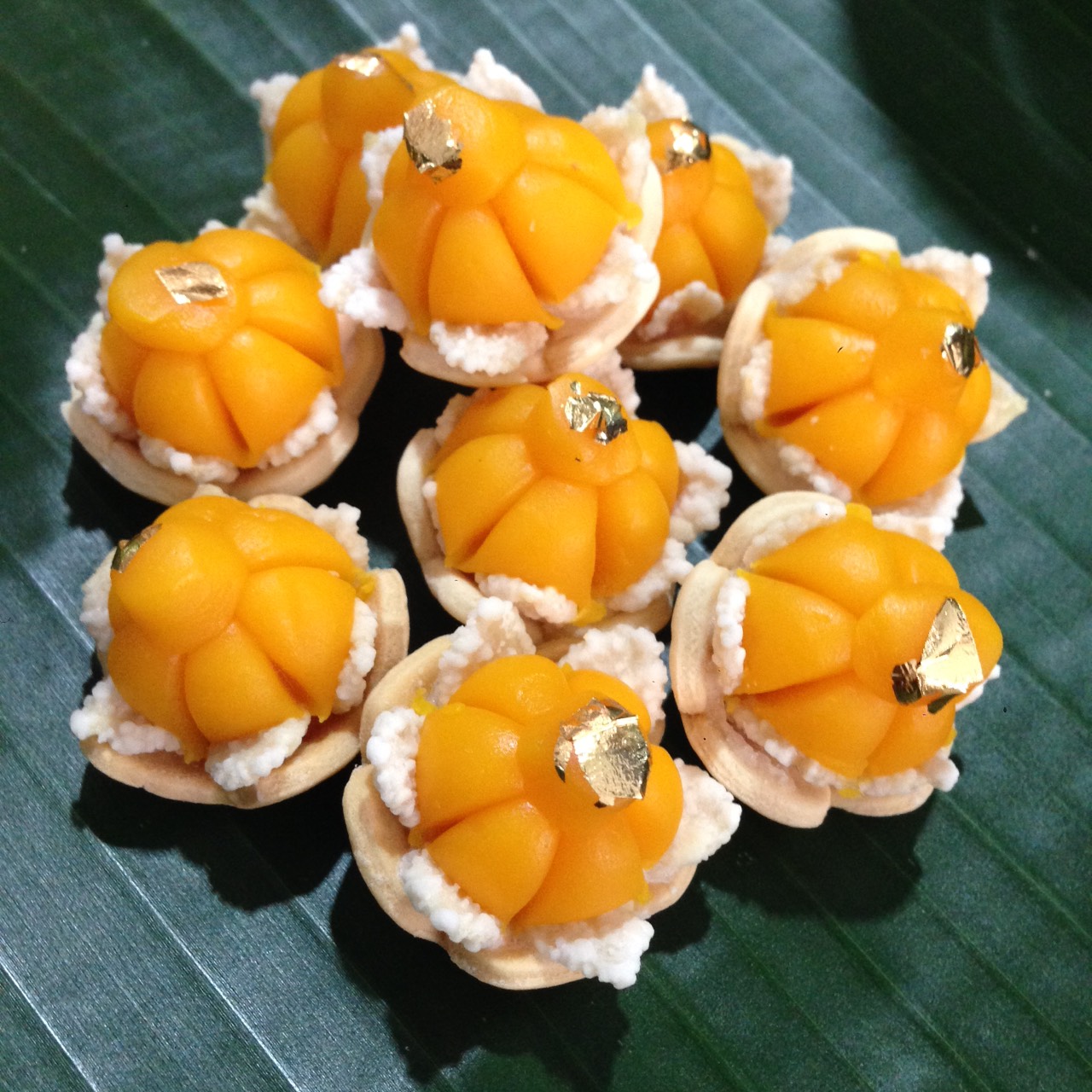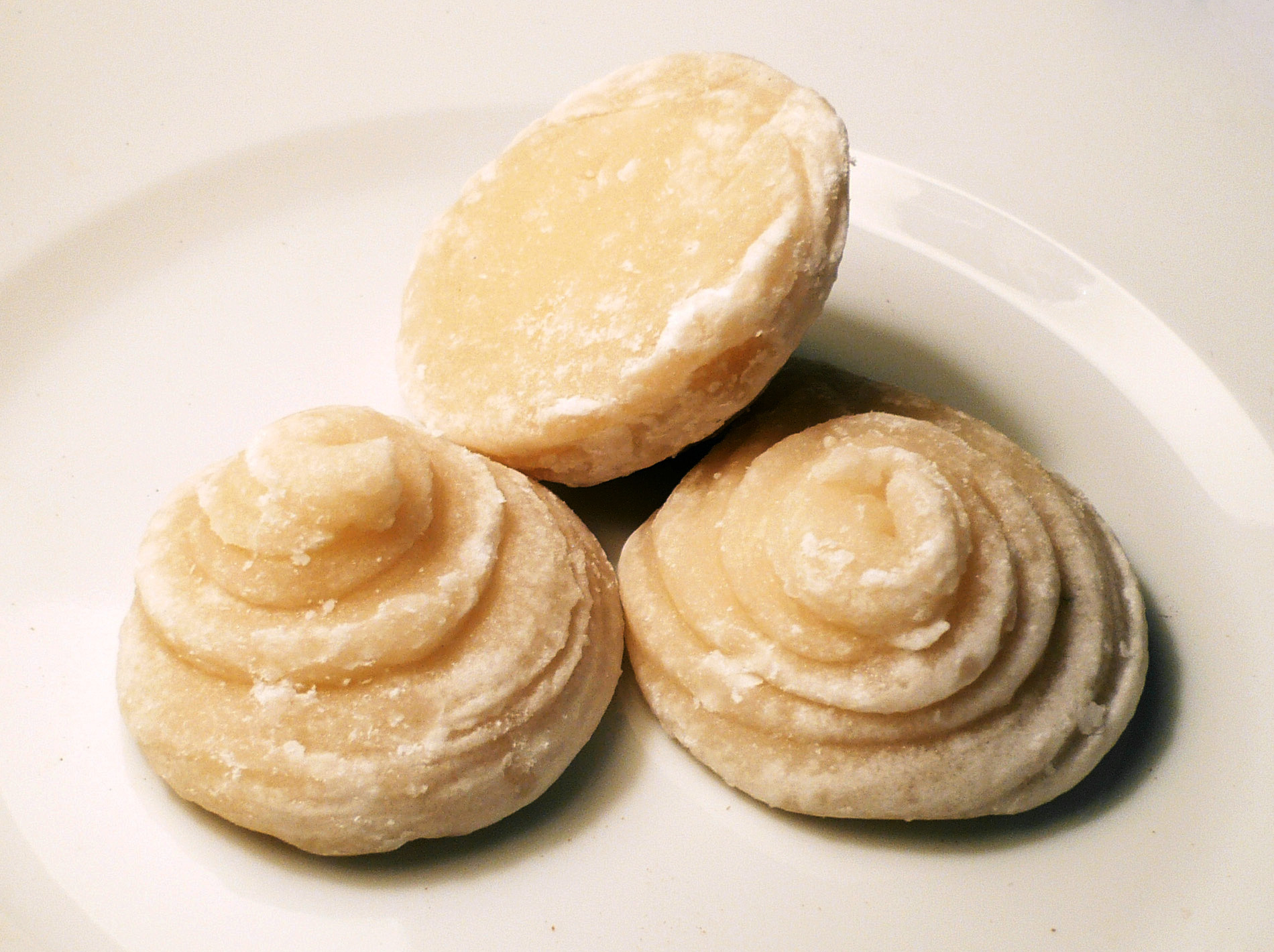|
Khanom Piakpun
''Khanom piak pun'' ( th, ขนมเปียกปูน ; literally "limewater-dampened sweets") is a type of Thai dessert. It is similar in texture to khanom chan, despite being different in appearance. Khanom chan can be peeled into layers, while ''khanom piak pun'' is solid throughout. Ingredients It is made with rice flour, palm sugar and precipitated limewater (น้ำปูนใส; ; ). The word ปูน (lime) gives sweet its name. The mixture is often thickened using arrowroot or tapioca starch. As a colouring, charred coconut coir (fibre from outer husk) or crushed pandan leaves may be added. The mixture is then heated on the brass pan before allowed to set on the tray. Grated coconut may be sprinkled as desired. Significance In common with other Thai desserts, Khanom piakpoon is part of religious ceremonies, such as almsgiving, house opening and funeral. See also * List of Thai desserts This is a list of Thai khanom, comprising snacks and desserts that are ... [...More Info...] [...Related Items...] OR: [Wikipedia] [Google] [Baidu] |
Thai Dessert
This is a list of Thai khanom, comprising snacks and desserts that are a part of Thai cuisine. Some of these dishes are also a part of other cuisines. The word "khanom" ( th, ขนม), refers to snack or dessert, presumably being a compound between two words, "khao" (ข้าว), "rice" and "khnom" (หนม), "sweet". The word "khanom" in the Thai sense is snack or sweet food made from flour. Thai khanom * '' Bua Loy, rice flour rolled into small balls and then cooked in coconut milk.'' * '' Bulan dan mek'' * '' Lot chong'' * '' Cha mongkut'' * ''Fakthong kaeng buat'' * '' Foi thong'' * Fresh fruit * ''Grass jelly'' * '' Khanom babin'' * '' Khanom bueang'' – known as Thai crêpes * ''Khanom chan'' – means layer dessert * ''Khanom keson lamchiak'' * ''Khanom khai pla'' * '' Khanom khrok'' * ''Khanom khuai ling'' * ''Khanom mo kaeng'' * ''Khanom namdokmai'' * ''Khanom phing'' * ''Khanom piakpun'' * ''Khanom sane chan'' * ''Khanom sot sai'' * '' Khanom ... [...More Info...] [...Related Items...] OR: [Wikipedia] [Google] [Baidu] |
Khanom Chan
Khanom chan ( th, ขนมชั้น, ) is an ancient Thai ''khanom'', or dessert, made of tapioca flour, rice flour, and coconut milk, among other ingredients. Originating from the Sukhothai Period, the dessert is a staple snack in Thai cuisine, and Thai people usually prepare it for auspicious ceremonies. Khanom chan is fragrant, subtly sweet, and slightly oily from the addition of the coconut milk; its texture is smooth yet sticky. Name and origin Its name derives from two Thai words: “''khanom''” ( th, ขนม) meaning "dessert", and “''chan''” ( th, ชั้น) meaning "layer" or "layers". The dessert has its origins in the Sukhothai Period, when foreign trade with China and India contributed to cultural exchanges, including that of food. As a result, the food was developed from ingredients that came from many nations and was adapted to suit the living conditions of local people. Usage In a complete serving, a minimum of nine layers of the dessert a ... [...More Info...] [...Related Items...] OR: [Wikipedia] [Google] [Baidu] |
Rice Flour
Rice flour (also rice powder) is a form of flour made from finely milled rice. It is distinct from rice starch, which is usually produced by steeping rice in lye. Rice flour is a common substitute for wheat flour. It is also used as a thickening agent in recipes that are refrigerated or frozen since it inhibits liquid separation. Rice flour may be made from either white rice or brown rice. To make the flour, the husk of rice or paddy is removed and raw rice is obtained, which is then ground to flour. Types and names By rice Rice flour can be made from indica, japonica, and wild rice varieties. Usually, rice flour ( zh, c=米粉, p=mǐfěn, ja, 米粉, komeko, ko, 쌀가루, ssal-garu, vi, bột gạo, th, แป้งข้าวเจ้า, paeng khao chao, lo, ແປ້ງເຂົ້າຈ້າວ, pèng khao chao, km, ម្សៅអង្ករ, msau ângkâ, my, ဆန်မှုန့်, hcan hmun, ms, tepung beras, tr, pirinç) refers to flour made f ... [...More Info...] [...Related Items...] OR: [Wikipedia] [Google] [Baidu] |
Palm Sugar
Palm sugar is a sweetener derived from any variety of palm tree. Palm sugar is sometimes qualified by the type of palm, as in coconut palm sugar. While sugars from different palms may have slightly different compositions, all are processed similarly and can be used interchangeably. Types The predominant sources of palm sugar are the Palmyra, date, nipa, sugar and coconut palms. The Palmyra palm (''Borassus'' spp.) is grown in Africa, Asia, and New Guinea. The tree has many uses, such as thatching, hatmaking, timber, use as a writing material, and in food products. Palm sugar is produced from sap ('toddy') from the flowers. The date palm has two species, ''Phoenix dactylifera'' and '' P. sylvestris'', and both are sources of palm sugar. ''P. dactylifera'' is common in the Mediterranean and Middle East. ''P. sylvestris'' is native to Asia, mainly Pakistan and India. Date palms are cultivated mainly for dates. Palm sugar is made from the tree's sap. The nipa palm (''Ny ... [...More Info...] [...Related Items...] OR: [Wikipedia] [Google] [Baidu] |
Precipitation (chemistry)
In an aqueous solution, precipitation is the process of transforming a dissolved chemical substance, substance into an insoluble solid from a Supersaturated solution, super-saturated solution. The solid formed is called the precipitate. In case of an inorganic chemical reaction leading to precipitation, the chemical reagent causing the solid to form is called the ''precipitant''. The clear liquid remaining above the precipitated or the centrifuged solid phase is also called the 'supernate' or 'supernatant'. The notion of precipitation can also be extended to other domains of chemistry (organic chemistry and biochemistry) and even be applied to the solid phases (''e.g.'', metallurgy and alloys) when solid impurities Segregation (materials science), segregate from a solid phase. Supersaturation The precipitation of a compound may occur when its concentration exceeds its solubility. This can be due to temperature changes, solvent evaporation, or by mixing solvents. Precipitatio ... [...More Info...] [...Related Items...] OR: [Wikipedia] [Google] [Baidu] |
Limewater
Limewater is the common name for a saturated aqueous solution of calcium hydroxide. Calcium hydroxide, Ca(OH)2, is sparsely soluble at room temperature in water (1.5 g/L at 25 °C). "Pure" (i.e. less than or fully saturated) limewater is clear and colorless, with a slight earthy smell and an astringent/bitter taste. It is basic in nature with a pH of 12.4. Limewater may be prepared by mixing calcium hydroxide (Ca(OH)2) with water and removing excess undissolved solute (e.g. by filtration). When excess calcium hydroxide is added (or when environmental conditions are altered, e.g. when its temperature is raised sufficiently), a milky solution results due to the homogeneous suspension of excess calcium hydroxide. This liquid has been known traditionally as milk of lime. Chemistry An experiment commonly used to demonstrate the interaction of CO2 and Ca(OH)2 is as follows. Resultant carbon dioxide passed through limewater in the right tube, producing a milky solution due ... [...More Info...] [...Related Items...] OR: [Wikipedia] [Google] [Baidu] |
Limestone
Limestone ( calcium carbonate ) is a type of carbonate sedimentary rock which is the main source of the material lime. It is composed mostly of the minerals calcite and aragonite, which are different crystal forms of . Limestone forms when these minerals precipitate out of water containing dissolved calcium. This can take place through both biological and nonbiological processes, though biological processes, such as the accumulation of corals and shells in the sea, have likely been more important for the last 540 million years. Limestone often contains fossils which provide scientists with information on ancient environments and on the evolution of life. About 20% to 25% of sedimentary rock is carbonate rock, and most of this is limestone. The remaining carbonate rock is mostly dolomite, a closely related rock, which contains a high percentage of the mineral dolomite, . ''Magnesian limestone'' is an obsolete and poorly-defined term used variously for dolomite, for limes ... [...More Info...] [...Related Items...] OR: [Wikipedia] [Google] [Baidu] |
Arrowroot
Arrowroot is a starch obtained from the rhizomes (rootstock) of several tropical plants, traditionally ''Maranta arundinacea'', but also Florida arrowroot from ''Zamia integrifolia'', and tapioca from cassava (''Manihot esculenta''), which is often labelled as arrowroot. Polynesian arrowroot or pia (''Tacca leontopetaloides''), and Japanese arrowroot (''Pueraria lobata''), also called kudzu, are used in similar ways. History Archaeological studies in the Americas show evidence of arrowroot cultivation as early as 7,000 years ago. The name may come from ''aru-aru'' (meal of meals) in the language of the Caribbean Arawak peoples, Arawak people, for whom the plant was a staple. It has also been suggested that the name comes from arrowroot's use in treating poison-arrow wounds, as it draws out the poison when applied to the site of the injury. In the early days of carbonless copy paper, arrowroot, because of its fine grain-size, was a widely used ingredient. After an economical way ... [...More Info...] [...Related Items...] OR: [Wikipedia] [Google] [Baidu] |
Tapioca
Tapioca (; ) is a starch extracted from the storage roots of the cassava plant (''Manihot esculenta,'' also known as manioc), a species native to the North Region, Brazil, North and Northeast Region, Brazil, Northeast regions of Brazil, but whose use is now spread throughout South America. It is a perennial shrub adapted to the hot conditions of tropical lowlands. Cassava copes better with poor soils than many other food plants. Tapioca is a staple food for millions of people in tropical countries. It provides only carbohydrate food value, and is low in protein, vitamins and Mineral (nutrient), minerals. In other countries, it is used as a thickening agent in various manufactured foods. Etymology and origin ''Tapioca'' is derived from the word ''tipi'óka'', its name in the Tupi–Guarani languages, Tupi language spoken by natives when the Portuguese first arrived in the Northeast Region of Brazil around 1500. This Tupi word is translated as 'sediment' or 'coagulant' and refe ... [...More Info...] [...Related Items...] OR: [Wikipedia] [Google] [Baidu] |
Coir
Coir (), also called coconut fibre, is a natural fibre extracted from the outer husk of coconut and used in products such as floor mats, doormats, brushes, and mattresses. Coir is the fibrous material found between the hard, internal shell and the outer coat of a coconut. Other uses of brown coir (made from ripe coconut) are in upholstery padding, sacking and horticulture. White coir, harvested from unripe coconuts, is used for making finer brushes, string, rope and fishing nets. It has the advantage of not sinking, so can be used in long lengths in deep water without the added weight dragging down boats and buoys. Coir must not be confused with coir pith, which is the powdery and spongy material resulting from the processing of the coir fibre. Coir fibre is locally named 'coprah' in some countries, adding to confusion. Pith is chemically similar to coir, but contains much shorter fibers. The name coco peat may refer either to coir or the pith or a mixture, as both have go ... [...More Info...] [...Related Items...] OR: [Wikipedia] [Google] [Baidu] |
Pandan Leaf
''Pandanus amaryllifolius'' is a tropical plant in the ''Pandanus'' (screwpine) genus, which is commonly known as pandan (; ). It has fragrant leaves which are used widely for flavouring in the cuisines of Southeast Asia and South Asia. Occurrence and habitat ''Pandanus amaryllifolius'' is a true cultigen, and is believed to have been domesticated in ancient times. It is sterile and can only reproduce vegetatively through suckers or cuttings. It was first described from specimens from the Maluku Islands, and the rare presence of male flowers in these specimens may indicate that it is the origin of the species. However, as no other wild specimens have been found, this is still conjecture. The plant is grown widely throughout Southeast Asia and South Asia. Botanical features The characteristic aroma of pandan is caused by the aroma compound 2-acetyl-1-pyrroline, found in the lower epidermal papillae; the compound gives white bread, jasmine rice, and basmati rice (as well as brea ... [...More Info...] [...Related Items...] OR: [Wikipedia] [Google] [Baidu] |







